Giuliani, McCain Closest to Voters
A new Pew Research Center study shows how Americans view the major candidates for the presidency in ideological terms:
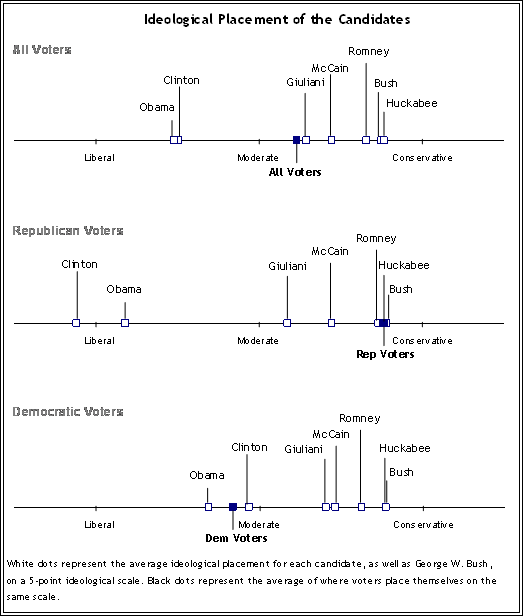
Here are the actual numbers:
The black dots represent the self-identified ideology of each sample. Thus, Rudy Giuliani and John McCain have to be pleased by the results.
Matt Yglesias correctly notes that it’s “bad news for liberals” that “the self-assessed ideology of the American people is still somewhat right of center.” But it’s worse than that: All of the Republican candidates are considerably closer to the average voter (in the perception of said average voter, at least) than is Hillary Clinton.
Further, while Matt’s right that Republican voters view Clinton and Obama as much further to the left than does the average voter, Democratic voters view all the Republicans — even Huckabee — as only moderately conservative. And even Democrats rate Obama as “liberal.”
To be sure, the current head-to-head polls show any plausible Democrat beating any plausible Republican except John McCain, so there’s plenty of reason for Democrats to be optimistic. But the fact that American voters are ideologically closer to the Republicans almost always gives the GOP a fighting chance.
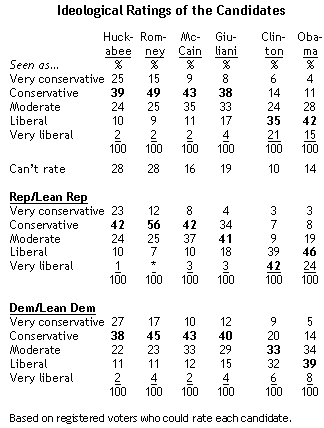


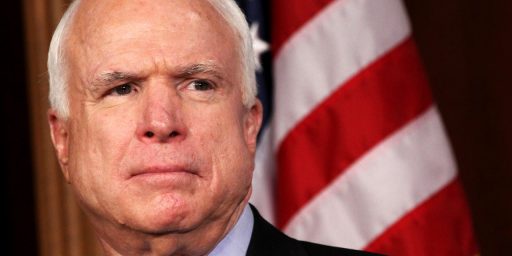
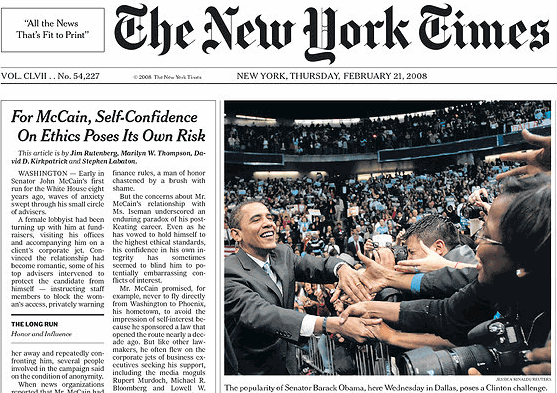
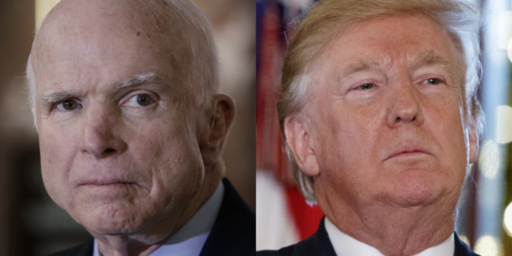
And during the election whomever is the GOP candidate will point out whomever is the democratic candidate is a liberal. The left will rant and rave about it. If the label sticks (and outside of democratic circles I think this data shows that it will), the voters overall will shy away from that person.
One of the things I find interesting about the data is how the left views Bush and Huckabee as the most conservative. While they are probably two of the more evangelical oriented in the survey, they aren’t necessarily the most conservative. Of course on the flip side, you can make a serious argument that the GOP view of Clinton as being significantly more liberal that Obama has more to do with not liking Clinton than the actual record (where I think Obama is actually more liberal the Clinton).
Looking closer into the data, Clinton leads among every democratic group pre-Iowa except blacks where she was on the wrong side of a 45-47 split (aka it was close). The next closest was a 35 to 31 Hillary lead on those making > $75K, college grads (38 to 32) and 18-49 year old (40 to 34). Every other lead was in double digits, some 2 to 1 leads. Post NH, Obama leads among blacks (52-33), college grads (39-33) and >$75K (44-35). It is now close among ‘liberal’ (37 – 35 for Clinton) and 18-49 (44-36 Clinton) and Men (41-36 Clinton). Everything else remains double digits for Clinton. Clinton leading among the different constituents should put her where she was before, the most likely winner. Which could cause some serious reconsideration for the one democratic group that Obama has a double digit lead, Blacks. Though it is worth a caveat to note that the N for the Black voters was a very low 92, so things could really be close to the original 45-47 split given the high margin of error associated with such a small N.
What is also interesting is to see the “who has the best chance to win”. This is a great question for evaluating how much the respondent can put themselves in others shoes vs what they would like to see. On the republican side, the candidates who came closest to the mythical center point (how people judge themselves) where McCain and Rudy. And the republicans have pretty much reversed from 45-17 Rudy V McCain in Nov. to 16-42 Rudy V McCain in Jan.
The democrats went from 59 Clinton – 14 Obama in Nov. to 46 Clinton – 35 Obama in Jan. But both of those are so far from the center point of voters as to be not in the same league.
Who exactly thinks Bush is a “conservative”? Clearly, the spending mad, government authority loving Bush is not even close to conservative ideals.
Or has the definition of conservative changed, and it now means someone who is ignorant, likes to blow things up and substitutes wrapping oneself in the flag for having any actual ideas?
anjin-san,
The republican side of that chart probably makes more sense if you viewed it in terms of purely social conservative issues. Or at least that seems to me the best way to get the data to line up with reality. It certainly doesn’t match up well if you look at it from a spending, tax cutting, national security or immigration stand point.
Very interesting on a number of counts. Most people nearly always self-identify as moderates regardless of what their actual views are. In this particular study note that’s what Democratic voters are doing. But not Republicans. Interesting, that.
I think their relative placement of the various presidential candidates is interesting, too. Note the placement of Romney. I don’t see it.
From my point of view all of the candidates should be clustered more tightly together, with Giuliani just about in the center, Romney just a little to his right, and McCain just a little farther right than that. I think that Democrats’ positioning of Clinton and Obama is about right but I think that everybody sees more space between Clinton and Giuliani than there actually is. Maybe they know something I don’t.
What’s most humorous, and I think directly attributable to media coverage, is that republicans (whose candidates are extremely moderate, save for Thompson and Paul) see their candidates as conservative. However, democrats (whose candidates are more liberal than the republicans are conservative) see themselves as moderate. This either shows a skewed perception of what is conservative vs. liberal or success on the part of liberals–through the media–of convincing people that their views (despite people self-identifying as conservative) are mainstream.
What I think the survey does illustrate is the success the Right has had in demonizing the word liberal while embracing the word conservative.
The messaging of the parties has been quite different. The Dems portray themselves and their positions as centrist while the Reps unabashedly portray themselves as conservative and any issue they oppose as of the far left. Both do this regardless of how the issue is viewed by the public at large. The people can break 1 to 1 or 2 to 1 and the messaging stays the same.
I think Dave’s assessment of where the candidates actually fall is more or less correct and YAJ is correct in stating that the views expressed in the poll have much more to do with social issues than fiscal or defense issues.
The “Pew research center” calls itself a “fact tank”. If this is so , it only goes to prove that there is more to truth than facts.
Charts made from manipulated definitions subjectively interpreted and foisted off as legitimate research. It’s no wonder we can’t have effective political discourse in this country.
Bush? Conservative? Give me a break. He’s done nothing but spend money and expand the government.